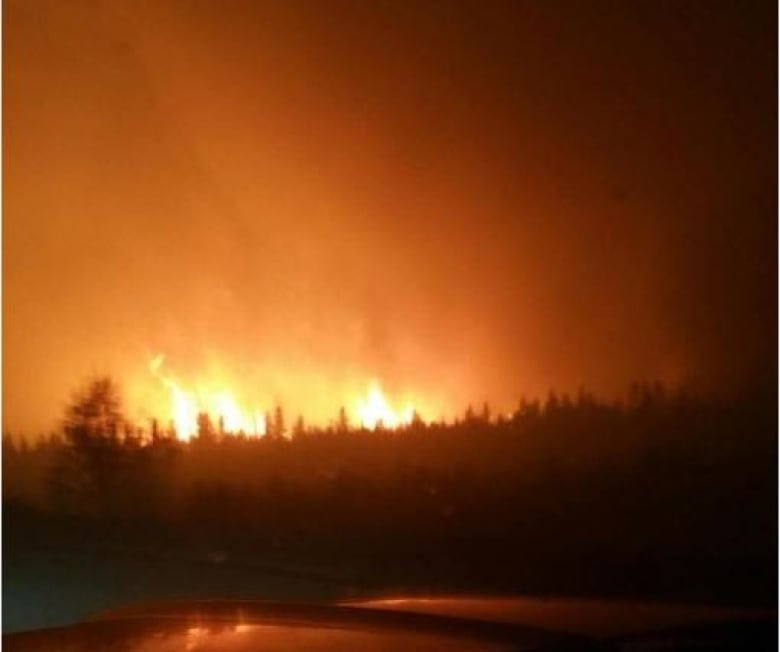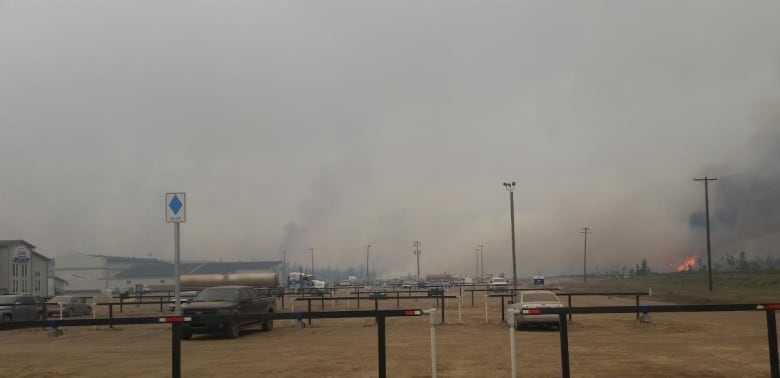Fort McMurray fire sweeps east through northern oilsands sites
Fire destroys lodge for workers north of the city
The Fort McMurray wildfire has destroyed one of the oilsands camps north of the city and is roaring eastward toward others in its path.
The fire destroyed all 665 units at Blacksand Executive Lodge, which provided temporary housing for workers in nearby oil facilities, on Tuesday morning. By Tuesday afternoon, flames were at the edges of the Noralta Lodge camp, just a few kilometres east of Blacksand.
CBC News also obtained photos of flames at the edges of an AFD Petroleum facility, about five kilometres northwest of Noralta.

- High winds push 'beast' wildfire near Suncor and Syncrude plants
- Growing wildfire forces evacuation of Fort McMurray oilsands camps
- Hazardous smoke and hot spots slow re-entry plans for Fort McMurray
Businesses in the area have been alerted. "We have an evacuation plan and we're ready to use it," said Dave Harman, a director for the Northlands Sawmill.
On Tuesday afternoon, he and a small team of colleagues were preparing the sawmill site for the fire. They had started bulldozing trees and brush to make wide fire breaksjust days after the first fires hit FortMcMurray. Harman said they have now brought in a water cannon and 70 sprinklers.

Satellite view
The mass of flames some have come to call "the beast" is not a single fire, but rather several fires surroundingand within the town of Fort McMurray.
NASA's Suomi NPP satellite collected images of what its office called "the myriad of fires in the Fort McMurray complex" on May 16.
You just get on those buses and pray that you're headed away from the danger.- B.J. Spears, oil worker
The photos show huge columns of smoke and several actively burning spots.
Air pollution levels in the Fort McMurray area have been extremely high this week, with off-the-chart ratings of 38 measured Monday morning (typically, "extreme risk" in Alberta is measured as a 10).
Alberta Health Services warned workers in the area including firefighters should wear N95 masks and to limit the amount of work they do outside each day.
Officials said the conditions are likely to hinder both firefighting effortsand attempts to get the town and surrounding areas ready for the return ofan estimated 94,000 evacuees displaced by the fire.
Saskatchewan border
The leading eastern edge of the Alberta fires was expected to reach the Saskatchewan border by the end of Tuesday.
Provincial government spokeswoman Kathy Young said in an emailthat Saskatchewan wildfire staff had already been called to help fight the blazeand were preparing for its arrival.
"Once it reaches the border, the fire will still be more than 40 kilometres from any Saskatchewan community, and numerous lakes, swamp and old burns in the area where the fire is projected to enter Saskatchewan will assist firefighters," she wrote.
"There is no immediate threat to any Saskatchewan communities."
Thousands of workers told to leave
The destruction of the Blacksandlodgecame just hours after thousands of workers were told to leave the area.The sky glowed orange from the southwest as thousands of workers from camps outside the town were directed to get on buses and leave.

Notleyconfirmedthat roughly 8,000 workers were affected by Monday's newevacuation order, and estimated some 6,000 were leftin the north.
"It's so scary and intimidating," said oil worker B.J. Spears, in an interview Tuesday morning.
He was sent home during the first wave of evacuations, when the province cleared the northern camps of all non-essential workers during the weekend of May 7. After five days in Ontario, Spears was called back to stay and work out of Noralta Lodge.
He arrived Sunday and worked an overnight shift. When he awoke Monday afternoon, authorities told him it was time to leave.

Spears said he and about 2,000 other workers were sent to a camp farther north called McClelland Lake Lodge, near Suncor's Fort Hills site. He saidsupervisors told themTuesday to stay in their roomsand wait for news.
But he and someof his colleagues wonder why they're staying put.
"I don't know what they're waiting for," Spearssaid.
Notley saidshe's confident energy companies can airlift the remaining workers out if needed. Shesaidthe fire was expected to move east, not north, on Tuesday.
As of 10 p.m. Monday night, 19 oil sites and camps north of Fort McMurray were under a mandatory evacuation order, including the Syncrude and Suncorproductionfacilities south of Fort MacKay.














_(720p).jpg)


 OFFICIAL HD MUSIC VIDEO.jpg)
.jpg)



























































































